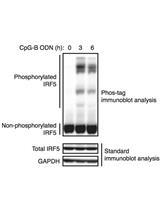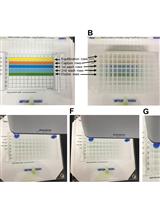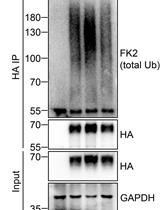- EN - English
- CN - 中文
Nanofluidic Proteomic Immunoassay
纳流体蛋白质组免疫分析
发布: 2015年07月20日第5卷第14期 DOI: 10.21769/BioProtoc.1537 浏览次数: 8553
评审: Pia GiovannelliAnonymous reviewer(s)
Abstract
Nanofluidic proteomic immunoassay (NIA), consisting of isoelectric focusing followed by sensitive chemiluminescence detection, has the potential to quantitatively characterize protein post-translational modifications that cause shifts in isoelectric point (pI). This protocol details the NIA analysis of protein phosphorylation using AKT as an example.
This protocol can be used for two platforms, NanoPro 1000 and Peggy Sue, from ProteinSimple Company. NanoPro 1000 separates proteins based on charge. Peggy Sue separates proteins based on either charge or size. The platforms can analyze up to 96 samples at a time with lysates from as few as 25 cells per assay. Detailed information of the platforms is available on ProteinSimple’s website (http://www.proteinsimple.com).
Background
Materials and Reagents
- Reagents from ProteinSimple
- 25x aqueous protease/phosphatase inhibitor mix (ProteinSimple, catalog number: 040482 )
- 50x DMSO protease/phosphatase inhibitor mix (ProteinSimple, catalog number: 040510 )
- Premix G2 (Servalyt pH 5-8 separation gradient) (ProteinSimple, catalog number: 040974 )
- Premix G2 (pH 5-6 separation gradient) (ProteinSimple, catalog number: 040971 )
- PI standard 5.5 (ProteinSimple, catalog number: 040028 )
- PI standard ladder 3 (ProteinSimple, catalog number: 040646 )
- Anolyte refill (ProteinSimple, catalog number: 040337 )
- Catholyte refill (ProteinSimple, catalog number: 040338 )
- Wash concentrate refill (ProteinSimple, catalog number: 041108 )
- Amplified rabbit secondary antibody detection kit (ProteinSimple, catalog number: 041126 )
- Peroxide XDR (ProteinSimple, catalog number: 041084 )
- Amplified rabbit secondary antibody detection kit (includes SA-HRP conjugate, secondary goat-anti-rabbit-biotin conjugate and antibody diluent) (ProteinSimple, catalog number: 041126 )
- RIPA lysis buffer (ProteinSimple, catalog number: 040483 ) (see Recipes)
- Bicine/CHAPS lysis buffer and sample diluent (ProteinSimple, catalog number: 040764 ) (see Recipes)
- Anolyte (10 mM Phosphoric Acid) (see Recipes)
- Catholyte (100 mM Sodium Hydroxide) (see Recipes)
- 25x aqueous protease/phosphatase inhibitor mix (ProteinSimple, catalog number: 040482 )
- Antibodies for AKT analysis
- AKT (pan) antibody (Cell Signaling Technology, catalog number: 4691 )
- AKT1 antibody (BD Biosciences, catalog number: 610861 )
- AKT2 antibody (Cell Signaling Technology, catalog number: 3063 )
- Phospho-AKT (Thr308) (Cell Signaling Technology, catalog number: 2965 )
- Phospho-AKT (Thr450) (Cell Signaling Technology, catalog number: 9267 )
- Phospho-AKT (Ser473) (Cell Signaling Technology, catalog number: 9271 )
- AKT (pan) antibody (Cell Signaling Technology, catalog number: 4691 )
- Other materials
- BCA protein assay kit (Pierce Antibodies, catalog number: 23225 )
- Dulbecco’s Modification of Eagle’s Medium (DMEM) with 4.5 g/L glucose & L-glutamine without pyruvate (Mediatech, catalog number: 10017CV )
- McCoy’s 5A (1x, with L-glutamine) (Mediatech, catalog number: 10050CV )
- Fetal bovine serum (FBS) (Life Technologies, Gibco®, catalog number: 10438026 )
- BCA protein assay kit (Pierce Antibodies, catalog number: 23225 )
Equipment
- NP1000 or Peggy (ProteinSimple, model: 004800 )
- Centrifuge for microplates (Thermo Fisher Scientific, model: Sorvall Legend XTR )
- Capillaries Charge Separation (ProteinSimple, catalog number: CBS701 )
- Assay Plate/Lid Kit (ProteinSimple, catalog number: 040663 )
- Sponge Pack (ProteinSimple, catalog number: 041528 )
- Tissue culture dish (100 mm) (Corning Incorporated, catalog number: 430167 )
- Microcentrifuge tube (Denville Scientific, catalog number: C2170 )
Software
- Compass version 2.5.11 (ProteinSimple)
Procedure
文章信息
版权信息
© 2015 The Authors; exclusive licensee Bio-protocol LLC.
如何引用
Guo, H., Lorenzi, P. L. and Ding, Z. (2015). Nanofluidic Proteomic Immunoassay. Bio-protocol 5(14): e1537. DOI: 10.21769/BioProtoc.1537.
分类
生物化学 > 蛋白质 > 修饰
您对这篇实验方法有问题吗?
在此处发布您的问题,我们将邀请本文作者来回答。同时,我们会将您的问题发布到Bio-protocol Exchange,以便寻求社区成员的帮助。
提问指南
+ 问题描述
写下详细的问题描述,包括所有有助于他人回答您问题的信息(例如实验过程、条件和相关图像等)。
Share
Bluesky
X
Copy link













